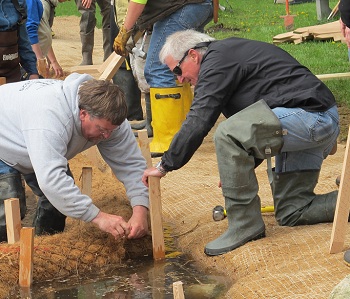Constructing a natural lakeshore with Certified Natural Shoreline Professional
Certification training provides hands-on experiential learning for Michigan’s lake-front contractors while creating natural shoreline demonstration sites accessible to the public.
A previous article introduced the Michigan Natural Shoreline Partnership’s (MNSP) new certification training program entitled, Certified Natural Shoreline Professional (CNSP). The current article will help readers understand the field component of CNSP.
 A popular feature of CNSP training is the field construction day. It provides participating contractors with hands-on experience installing a basic natural shoreline project. Field day sites are chosen carefully to provide experience with a simple design on a low energy shoreline of an inland lake. (Experience with higher energy shorelines and more advanced bioengineering techniques are made available through CNSP continuing education opportunities).
A popular feature of CNSP training is the field construction day. It provides participating contractors with hands-on experience installing a basic natural shoreline project. Field day sites are chosen carefully to provide experience with a simple design on a low energy shoreline of an inland lake. (Experience with higher energy shorelines and more advanced bioengineering techniques are made available through CNSP continuing education opportunities).
The basic design includes a six-foot wide buffer strip of native wetland and aquatic plants that is protected from wave and ice action by biodegradable linear shoreline protection – sometimes referred to as biolog – placed at the toe of the bank. These biologs are usually in the form of coir fiber logs, or sometimes brush bundles constructed on-site using non-invasive woody plant material. Emergent aquatic plants, planted into or immediately behind the logs, can eventually colonize the logs making them part of the restored shoreline. All of these techniques can be arranged to accommodate access to the lake. Lakefront property owners can learn more about basic natural shoreline designs in the MNSP’s guidebook for property owners.
Native wetland plants and shrubs are planted into an erosion control blanket to create a buffer strip that will stabilize soils, slow runoff, deter geese and attract songbirds and butterflies. Plant material may include bare root, plugs or quart and gallon containerized stock. If ducks and geese frequent the area, waterfowl exclusion fencing should be installed to protect new plantings. The fencing will need to be maintained until the plants are well established and can withstand grazing by waterfowl.
A five-minute video of a CNSP field construction day is available on the MNSP website along with a schedule of upcoming lake and natural shoreline events and a map of natural shoreline demonstration sites.



 Print
Print Email
Email


